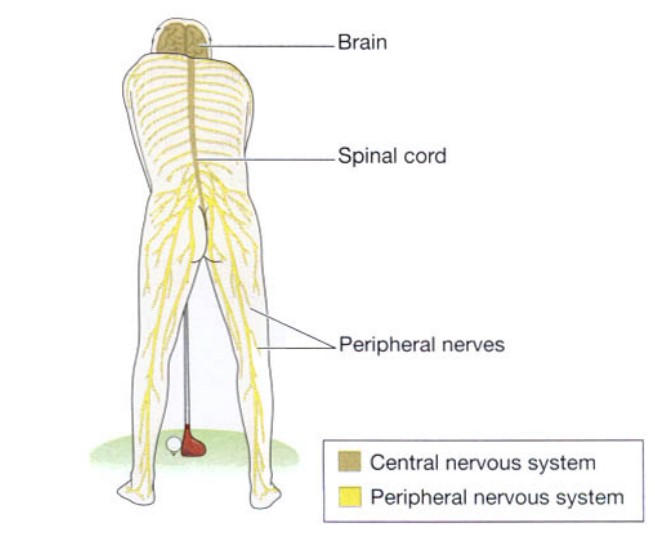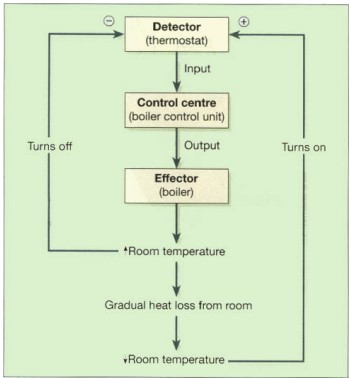Table of Contents
Communication and the nervous system
Internal communication: The nervous system is a rapid communication system. The main components are shown in the figure below.

The central nervous system-Internal communication
The central nervous system consists of
- The brain, situated inside the skull
- The spinal cord extends from the base of the skull to the lumbar region and is protected from injury by the bones of the spinal column.
The peripheral nervous system-Internal communication
The peripheral nervous system is a network of nerve fibers, which are
- Sensory or afferent, providing the brain with ‘input’ from organs and tissues, or
- Motor or efferent, which conveys nerve impulses carrying ‘output’ from the brain to effector organs: the muscles and glands.
The somatic (common) senses—pain, touch, heat, and cold—are triggered by the activation of specialized sensory receptors at nerve terminals that are distributed all over the body’s surface. In order to maintain posture and balance, various sensors in muscles and joints react to changes in the position and orientation of the body. Yet other receptors, such as those that regulate blood pressure, heart rate, and respiratory rate, are triggered by impulses in interior organs. Any of these receptors that are stimulated causes impulses to be carried by sensory (afferent) nerves to the brain. Electrical impulses created when nerve terminals are stimulated are used to communicate along nerve fibers (cells).
Since more than one nerve is involved in the series of events that take place between the original stimulus and the physiological response to it, communication between nerve cells is also necessary. By releasing a substance (the neurotransmitter) into the microscopic spaces between them, nerves may interact with one another. In order to ensure that the information is sent, the neurotransmitter swiftly crosses the gap and either activates or inhibits the subsequent nerve cell.
The relevant areas of the brain receive information from sensory nerves and chemicals that are circulating in the blood, compile it, and then reply via motor nerves to effector organs, frequently via a negative feedback process. Some of these processes—like pain—are cognitive and perceptible, whereas others—like changes in blood pressure—occur unconsciously. Adjustments to various bodily systems take place in a matter of seconds as a result of the quick reactions caused by nerve impulses traveling at high speeds through nerve fibers.
Communication and the endocrine system-Internal communication
The endocrine system is made up of several endocrine glands dispersed throughout the body. They create and release hormones, which are chemical messengers that go throughout the body in the blood. In addition to modulating metabolic and other cellular functions and controlling body growth and maturation, hormones also activate specific glands or tissues. Specific hormones are among the chemicals that endocrine glands measure in the blood and react to. Negative feedback systems are in charge of controlling changes in blood hormone levels. Compared to the neurological system, the endocrine system offers slower, more accurate regulation of bodily activities.
Communication with the external environment
Special senses
These senses arise following the stimulation of specialized sensory receptor cells located in sensory organs or tissues
in the head. The senses and the special organs involved are shown in Box the below.
Despite the fact that these senses are typically regarded as distinct and distinct from one another, one sense is rarely employed by itself shown in the figure below. For instance, other senses, including sight and hearing, are utilized to attempt and find the cause of a fire when the smell of smoke is detected. Similar to how taste and smell are directly related to whether or not food is enjoyed, The brain combines information from memory and incoming information to start a reaction by sending electrical impulses to effector organs, muscles, and glands through motor (efferent) neurons. Such reactions allow the person to put out the fire or get their digestive system ready for food.

Verbal communication
When we exhale, air passes through the area between our vocal cords and is created in the larynx, where it is used to communicate. Speech is the control of sound through the tongue and lower jaw motions, as well as the contraction of the cheek and throat muscles.
Non-verbal communication
Posture and movements are associated with non-verbal communication, e.g. nodding the head and shrugging the shoulders. The skeletal system provides the bony framework of the body, and movement takes place at joints between bones. Skeletal muscles which move the bones lie between them and the skin. They are stimulated by the part of the nervous system under conscious (voluntary) control. Some non-verbal communication, e.g. changes in facial expression, may not involve the movement of bones.

smell and taste.